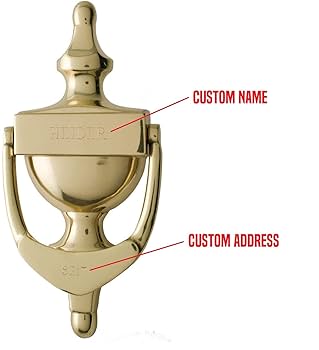Brass Door Knocker

The afternoon sun glinted off the polished brass, catching my eye as I approached the front door. Not just any door, mind you. This one, recently re-hung on custom-milled mahogany, demanded a certain… presence. Replacing the tired, generic knocker was paramount. I’m a stickler for detail, especially where acoustics are concerned.
So, I’ll be candid. At first glance, this brass knocker felt… substantial. Advertised as solid, its weight confirmed the claim. This matters. Thin brass, of the sort you often find masquerading as “quality,” offers a disappointingly tinny sound. This one? Resonant. A deep, satisfying thwack – precisely what a well-executed arrival should announce.
The measurements, 3-15/16” x 6-3/4”, proved spot-on for my application. Installation, true to the description, was uncomplicated. The included screws were of decent quality, a welcome change from the cheap, stripped-head offerings common in this market. You’ve seen them, the ones that chew up at the first sign of resistance. A word to the wise: pre-drill pilot holes in your door frame, especially if you’re dealing with hardwoods. You’ll thank me later.
Now, about that sound. A brass knocker’s timbre is, quite frankly, everything. Cheaper models utilize hollow casting. This leads to a fleeting, high-frequency ring, which gets lost amongst ambient noise. This model, however, possesses a richer, more complex harmonic profile. The sound carries, broadcasting the arrival with both authority and refinement. Think of it as the difference between a cheap trumpet and a hand-hammered French horn. Big difference.
One minor quibble, though, and this is where the pragmatism kicks in: the polished finish is undeniably beautiful, but it’s also prone to showing fingerprints. Seriously, you wouldn’t believe it. The solution is simple: a quick wipe down with a microfiber cloth after installation, and perhaps a maintenance routine every few months, depending on your climate and usage. Consider it part of the brass’s character. It’s not a flaw; it’s patina in the making.
I’ve seen some reviews compare this knocker to a competitor, a cast-iron model often recommended for heavier doors. Sure, cast iron is rugged. But cast iron lacks the elegant, almost musical quality of well-struck brass. And let’s be honest, the brass just looks better.
So, who is this knocker for? If you are looking to make a statement — a subtle signal of taste and care — this is your guy. For the discerning homeowner who appreciates quality and values a beautiful sound, you’ve found it. Go ahead. Buy one. Your door will thank you.